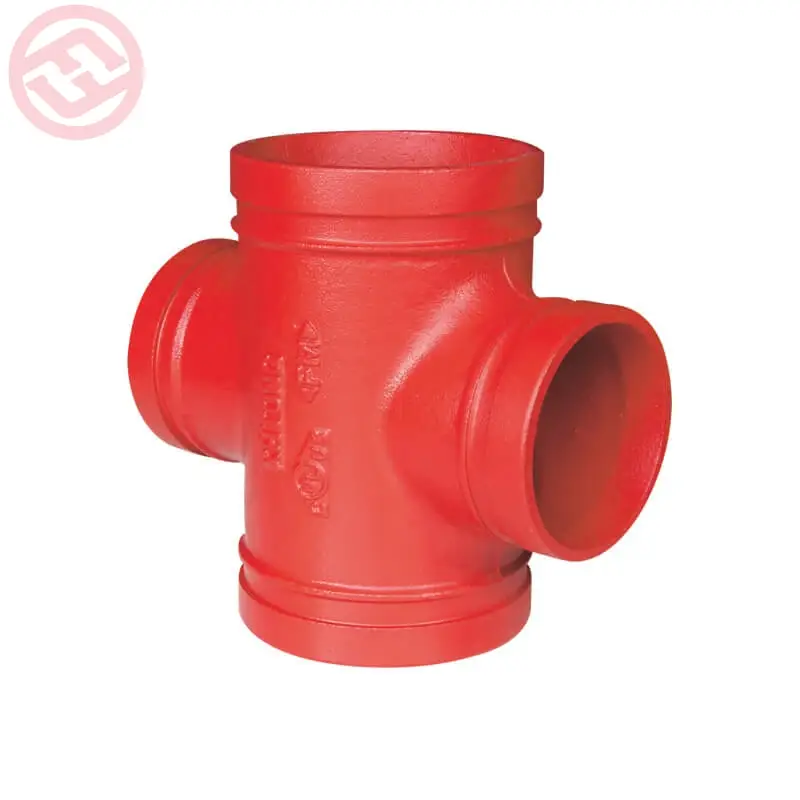Grooved crosses find application across various industries due to their versatility, reliability, and ease of installation.
Some of the primary industries and applications where grooved crosses are commonly utilized include:
- Fire Protection Systems: Grooved crosses are extensively used in fire protection systems, including sprinkler systems and firefighting pipelines, ensuring reliable distribution of water or fire suppressants.
- Commercial and Residential Construction: They are employed in plumbing systems within commercial buildings, residential complexes, and high-rise structures for water distribution and HVAC (Heating, Ventilation, and Air Conditioning) systems.
- Industrial Processes: Grooved crosses are used in industrial settings for various fluid distribution purposes, including in manufacturing facilities, chemical processing plants, and refineries, among others.
- Water and Wastewater Treatment: They play a role in water treatment facilities, sewage systems, and wastewater treatment plants, facilitating the flow of liquids and chemicals.
- Mining and Extractive Industries: Grooved crosses are utilized in mining operations for slurry transportation, handling process fluids, and maintaining the infrastructure in harsh and demanding environments.
- Oil and Gas Industry: They find applications in pipelines for oil, gas, and petrochemicals, ensuring proper flow distribution in both upstream and downstream operations.
- Marine and Offshore Installations: Grooved crosses are used in maritime applications, including on ships and offshore platforms, contributing to fluid distribution systems in these environments.
- Food and Beverage Processing: In the food and beverage industry, grooved crosses facilitate the movement of liquids and fluids in processing and packaging lines.
- Pharmaceutical and Biotechnology: They play a role in pharmaceutical manufacturing and biotech industries for fluid distribution in production and research facilities.
- Power Generation: Grooved crosses are utilized in power plants for cooling systems, piping networks, and fluid distribution within thermal, hydroelectric, and nuclear power facilities.
The adaptability and reliability of grooved crosses make them suitable for a wide range of applications, providing efficient and leak-resistant fluid distribution across diverse industries and environments.
Can you explain the installation process of grooved crosses and any considerations ?
Certainly! The installation process of grooved crosses involves several steps to ensure a secure and leak-free connection within a piping system. Here’s an overview:
- Prepare the Pipes and Components: Ensure the pipes and grooved crosses are clean, free from debris, and in good condition. Inspect the grooves to ensure they’re smooth and undamaged.
- Marking and Alignment: Mark the pipes to indicate the alignment and orientation of the grooved cross. Proper alignment is crucial for a secure connection and efficient flow within the system.
- Prepare Grooves and Gaskets: Confirm that the grooves on the pipes and the grooved cross match in size and depth. Insert the gasket into the grooves on the grooved cross, ensuring it is properly seated.
- Connection: Slide the grooved cross onto the pipes, aligning the grooves with the marked positions on the pipes. Ensure the gasket remains in place and properly seated within the grooves.
- Securing the Connection: Place the coupling housings over the grooved ends and align them with the grooves. Grooved Cross Tighten the bolts and nuts uniformly in a cross-pattern to apply even pressure, compressing the gasket and creating a secure seal.
- Torque Specifications: Follow the manufacturer’s torque specifications for tightening the bolts and nuts. Over-tightening can damage components, while under-tightening can lead to leaks.
- Inspection: After installation, visually inspect the connection to ensure proper alignment, sealing, and tightening. Check for any signs of misalignment, gaps, or irregularities that might compromise the seal.
Considerations:
- Tools and Equipment: Use appropriate tools, such as torque wrenches, to ensure accurate torque application and prevent over-tightening.
- Adherence to Manufacturer Guidelines: Adhere strictly to the manufacturer’s instructions and guidelines specific to the grooved cross and associated components.
- Proper Torque Sequence: Tighten bolts and nuts in the recommended sequence to ensure uniform pressure distribution and an effective seal.
- Quality Control: Ensure that the installation meets industry standards and regulations to maintain the integrity of the piping system.
- Professional Installation: Installation should be carried out by trained personnel familiar with grooved piping systems to prevent errors that may compromise the connection.
Following these steps and considerations is essential to ensure a properly installed grooved cross, providing a reliable and leak-free connection within the piping system.
